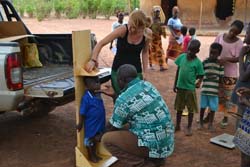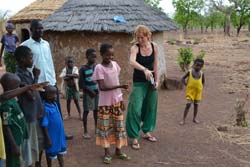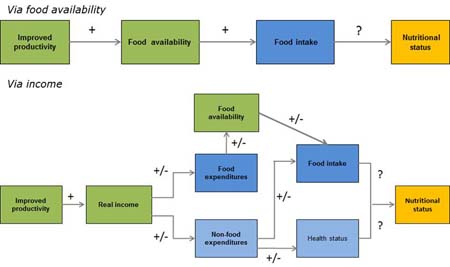Both protein-energy malnutrition and micronutrient deficiencies are highly prevalent in sub-Saharan Africa, especially among children and women of reproductive age. Undernutrition results in substantial increases in overall disease burden and mortality, decreases in intellectual development and reduction in productivity and economic development. Grain legumes add energy, proteins, minerals and B vitamins to the African diet. Evidence from randomized controlled trials show that the consumption of legume-based foods improves growth in children. Iron and zinc intake are low when consuming legume-based diets. However, methods like dephytinization and fortification seem to be promising in increasing iron and zinc bioavailability in legume-based foods and improving iron and zinc status of infants, children and women of reproductive age. Evidence concerning other micronutrients is inconsistent or poor (for more information see the literature review ‘Nutritional benefits of legume consumption at household level in rural sub-Saharan Africa’.
What is the impact of N2Africa on nutrition?
Recently, I conducted a nutrition case study in Northern Ghana (Karaga and Bawku West Districts) in February to March 2013, to investigate this question. The case study consisted of a quasi-experimental, cross-sectional study in villages that did and villages that did not receive N2Africa inputs between 2010 and 2012. Individual dietary diversity scores (IDDS) of children under 5 years of age were measured by 24-hour dietary recalls among their mothers. Nutritional status was measured by anthropometric measurements. Among N2Africa farmers, eight focus group discussions were held (four with male and four with female farmers).
 |
Left: Ilse doing height measurements Right: Random walk method-spinning the pen |
 |
Children of N2Africa participants have a significant more nutrient adequate diet as reflected by the individual dietary diversity score (IDDS) compared with non-N2Africa participants. Significantly more children of N2Africa participants consumed from the food group ‘legumes, seeds and nut’. There is no difference in nutritional status between children of N2Africa and children of non-N2Africa participants. This can be explained by the fact that nutritional status is a long-term effect and most N2Africa participants included in the study have only received inputs in 2012.
|
|

*P<0.05
|
Many steps link improved crops yields to nutrition. From the focus group discussions it seems that improved agricultural productivity may affect nutrition through different pathways: 1) via an increase in food availability for home consumption in case of female farmers and in case of farmers who received training on soybean preparation methods; 2) via an increase in income in case of male farmers. Whether an increase in income translates into improved nutritional status via an increase in food expenditures or non-food expenditures is unclear. Based on this study, to enhance benefits of agricultural interventions on nutrition via an increase in food availability for home consumption it can be recommended: to target female farmers, focus on crops mainly used for home consumption and provide training on preparation methods and general nutrition education.
For more information keep an eye on www.n2africa.tv for the film "Nutritional Benefit of Legume Cultivation in Northern Ghana", that is to be released soon.
Ilse de Jager

